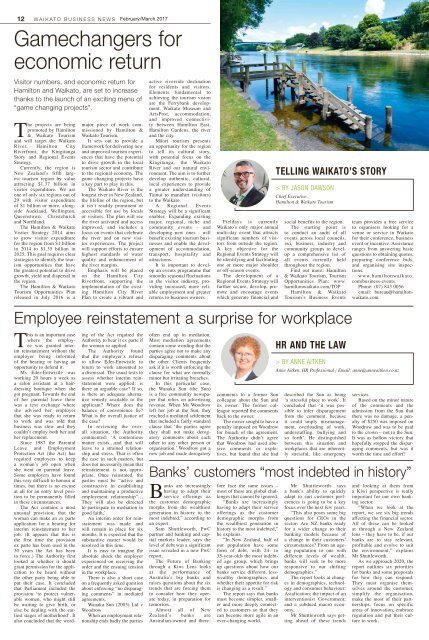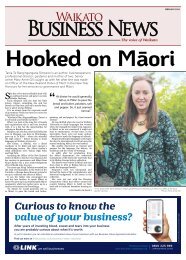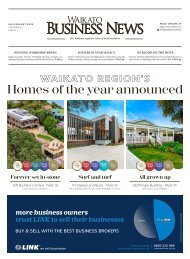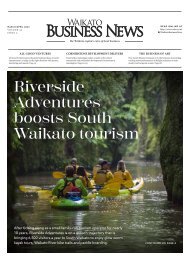Waikato Business News February/March 2017
Waikato Business News has for a quarter of a century been the voice of the region’s business community, a business community with a very real commitment to innovation and an ethos of co-operation.
Waikato Business News has for a quarter of a century been the
voice of the region’s business community, a business community
with a very real commitment to innovation and an ethos of
co-operation.
You also want an ePaper? Increase the reach of your titles
YUMPU automatically turns print PDFs into web optimized ePapers that Google loves.
12 WAIKATO BUSINESS NEWS <strong>February</strong>/<strong>March</strong> <strong>2017</strong><br />
Gamechangers for<br />
economic return<br />
Visitor numbers, and economic return for<br />
Hamilton and <strong>Waikato</strong>, are set to increase<br />
thanks to the launch of an exciting menu of<br />
“game changing projects”.<br />
The projects are being<br />
promoted by Hamilton<br />
& <strong>Waikato</strong> Tourism<br />
and will target the <strong>Waikato</strong><br />
River, Hamilton City<br />
Riverfront, the Kingitanga<br />
Story and Regional Events<br />
Strategy.<br />
Currently, the region is<br />
New Zealand’s fifth largest<br />
tourism region by value<br />
attracting $1.37 billion in<br />
visitor expenditure. We are<br />
one of only six regions out of<br />
29 with visitor expenditure<br />
of $1 billion or more, alongside<br />
Auckland, Wellington,<br />
Queenstown, Christchurch<br />
and Northland.<br />
The Hamilton & <strong>Waikato</strong><br />
Visitor Strategy 2014 aims<br />
to grow visitor expenditure<br />
for the region from $1 billion<br />
in 2014 to $1.35 billion in<br />
2025. This goal requires clear<br />
strategies to identify the tourism<br />
opportunities that have<br />
the greatest potential to drive<br />
growth, yield and dispersal in<br />
the region.<br />
The Hamilton & <strong>Waikato</strong><br />
Tourism Opportunities Plan<br />
released in July 2016 is a<br />
major piece of work commissioned<br />
by Hamilton &<br />
<strong>Waikato</strong> Tourism.<br />
It sets out to provide a<br />
framework for delivering new<br />
and improved tourism experiences<br />
that have the potential<br />
to drive growth in the local<br />
tourism sector and contribute<br />
to the regional economy. The<br />
game changing projects have<br />
a key part to play in this.<br />
The <strong>Waikato</strong> River is the<br />
longest river in New Zealand,<br />
the lifeline of the region, but<br />
it isn’t readily prominent or<br />
accessible for use by locals<br />
or visitors. The plan will see<br />
the river activated and access<br />
improved, and includes a<br />
focus on events that celebrate<br />
the river and on new visitor<br />
experiences. The project<br />
will support efforts to ensure<br />
highest standards of water<br />
quality and enhancement of<br />
the river margins.<br />
Emphasis will be placed<br />
on the Hamilton City<br />
Riverfront, supporting the<br />
implementation of the existing<br />
Hamilton City River<br />
Plan to create a vibrant and<br />
active riverside destination<br />
for residents and visitors.<br />
Elements fundamental to<br />
achieving the tourism vision<br />
are the Ferrybank development,<br />
<strong>Waikato</strong> Museum and<br />
ArtsPost, accommodation,<br />
and improved connectivity<br />
between Hamilton East,<br />
Hamilton Gardens, the river<br />
and the city.<br />
Māori tourism presents<br />
an opportunity for the region<br />
to tell its cultural story,<br />
with potential focus on the<br />
Kingitanga, the <strong>Waikato</strong><br />
River and our natural environment.<br />
The aim is to further<br />
develop authentic, cultural,<br />
local experiences to provide<br />
a greater understanding of<br />
Tainui to manuhiri (visitors)<br />
to the <strong>Waikato</strong>.<br />
A Regional Events<br />
Strategy will be a significant<br />
enabler. Expanding existing<br />
major, regional, niche and<br />
community events - and<br />
developing new ones - will<br />
benefit existing tourism businesses<br />
and enable the development<br />
of accommodation,<br />
transport, hospitality and<br />
attractions.<br />
It is important to develop<br />
an events programme that<br />
smooths seasonal fluctuations<br />
in the visitor industry, providing<br />
increased, more reliable<br />
employment and greater<br />
returns to business owners.<br />
Fieldays is currently<br />
<strong>Waikato</strong>'s only major annual<br />
multi-day event that attracts<br />
significant numbers of visitors<br />
from outside the region.<br />
A key objective for the<br />
Regional Events Strategy will<br />
be identifying and facilitating<br />
one or more major shoulder<br />
or off-season events.<br />
The development of a<br />
Regional Events Strategy will<br />
further secure, develop, promote<br />
and encourage events<br />
which generate financial and<br />
TELLING WAIKATO’S STORY<br />
> BY JASON DAWSON<br />
Chief Executive,<br />
Hamilton & <strong>Waikato</strong> Tourism<br />
social benefits to the region.<br />
The starting point is<br />
to conduct an audit of all<br />
events across local councils,<br />
iwi, business, industry and<br />
community groups to develop<br />
a comprehensive list of<br />
all events currently held<br />
throughout the region.<br />
Find out more: Hamilton<br />
& <strong>Waikato</strong> Tourism, Tourism<br />
Opportunities Plan: www.<br />
hamiltonwaikato.com/TOP<br />
Hamilton & <strong>Waikato</strong><br />
Tourism’s <strong>Business</strong> Events<br />
Employee reinstatement a surprise for workplace<br />
This is an important case<br />
where the employee<br />
was granted interim<br />
reinstatement without the<br />
employer being informed<br />
of the hearing or having an<br />
opportunity to defend it.<br />
Ms Eder-Entwistle was<br />
working 20 hours a week as<br />
a salon assistant at a hairdressing<br />
boutique when she<br />
got pregnant. Towards the end<br />
of her parental leave there<br />
was a text exchange where<br />
she advised her employer<br />
that she was ready to return<br />
to work and was told that<br />
business was slow and they<br />
couldn’t employ both her and<br />
her replacement.<br />
Since 1987 the Parental<br />
Leave and Employment<br />
Protection Act (the Act) has<br />
required employers to keep<br />
a woman’s job open when<br />
she went on parental leave.<br />
Some employers have found<br />
this very difficult to honour at<br />
times, but there is no excuse<br />
at all for an entry level position<br />
to be permanently filled<br />
in these circumstances.<br />
The Act contains a most<br />
unusual provision, that the<br />
woman can make an ex parte<br />
application for a hearing for<br />
interim reinstatement to her<br />
job. (It appears that this is<br />
the first time the provision<br />
ex parte has been used in the<br />
30 years the Act has been<br />
in force.) The Authority first<br />
looked at whether it should<br />
grant permission for the application<br />
to be heard without<br />
the other party being able to<br />
put their case. It concluded<br />
that Parliament included the<br />
provision ‘to protect vulnerable<br />
women, who might still<br />
be waiting to give birth, or<br />
else be dealing with the earliest<br />
stages of motherhood’. It<br />
also concluded that the wording<br />
of the Act required the<br />
Authority to hear it ex parte if<br />
the woman so applied.<br />
The Authority found<br />
that the employer’s refusal<br />
to allow Eder-Entwistle to<br />
return to work amounted to<br />
a dismissal. The usual tests to<br />
assess whether interim reinstatement<br />
were applied: is<br />
there an arguable case? If so,<br />
is there an adequate alternative<br />
remedy available to the<br />
applicant? Where does the<br />
balance of convenience lie?<br />
What is the overall justice of<br />
the case?<br />
In reviewing the overall<br />
situation, the Authority<br />
commented: ‘A contentious<br />
matter exists…and that will<br />
leave to a strained relationship<br />
and stress. That is often<br />
the case in such matters, but<br />
does not necessarily mean that<br />
reinstatement is not appropriate.<br />
Once reinstated, the<br />
parties must be “active and<br />
constructive in establishing<br />
and maintaining a productive<br />
employment relationship”…<br />
They will also be directed<br />
to participate in mediation in<br />
good faith.’<br />
An interim order for reinstatement<br />
was made and<br />
will remain in place for six<br />
months. It is expected that the<br />
substantive matter would be<br />
resolved in this time.<br />
It is easy to imagine the<br />
absolute shock the employer<br />
experienced on receiving the<br />
order and the ensuing tension<br />
in the workplace.<br />
There is also a short case<br />
on a frequently asked question<br />
about enforcing “no disparaging<br />
comments” in mediated<br />
agreements.<br />
Wanaka Sun (2003) Ltd v<br />
Woodrow<br />
When an employment relationship<br />
ends badly the parties<br />
often end up in mediation.<br />
Most mediation agreements<br />
contain some wording that the<br />
parties agree not to make any<br />
disparaging comments about<br />
the other. Clients frequently<br />
ask if it is worth enforcing the<br />
clause for what are normally<br />
minor but irritating breaches.<br />
In this particular case,<br />
the Wanaka Sun (the Sun)<br />
is a free community newspaper<br />
that relies on advertising<br />
revenue. When Ms Woodrow<br />
left her job at the Sun, they<br />
reached a mediated settlement<br />
that included a fairly standard<br />
clause that ‘the parties agree<br />
they shall not make derogatory<br />
comments about each<br />
other to any other person or<br />
organisation.’ Woodrow got a<br />
new job and made derogatory<br />
comments to a former Sun<br />
colleague about the Sun and<br />
its owner. The former colleague<br />
reported the comments<br />
back to the owner.<br />
The owner sought to have a<br />
penalty imposed on Woodrow<br />
for breach of the agreement.<br />
The Authority didn’t agree<br />
that Woodrow had used abusive<br />
comments or expletives,<br />
but found that she had<br />
HR AND THE LAW<br />
> BY ANNE AITKEN<br />
team provides a free service<br />
to organisers looking for a<br />
venue or service in <strong>Waikato</strong><br />
for their conference, business<br />
event or incentive. Assistance<br />
ranges from answering basic<br />
questions to obtaining quotes,<br />
preparing conference bids,<br />
and organising site inspections.<br />
www.hamiltonwaikato.<br />
com/business-events<br />
Phone: (07) 843 0056<br />
email: bureau@hamiltonwaikato.com<br />
Anne Aitken, HR Professional | Email: anne@anneaitken.co.nz<br />
described the Sun as being<br />
‘a stressful place to work’. It<br />
concluded that ‘it was possible<br />
to infer disparagement<br />
from the comment, because<br />
it could imply mismanagement,<br />
overloading of work,<br />
understaffing, bullying and<br />
so forth’. He distinguished<br />
between this situation and<br />
workplaces that are inherently<br />
stressful, like emergency<br />
services.<br />
Based on the minor nature<br />
of the comments and the<br />
admission from the Sun that<br />
there was no damage, a penalty<br />
of $250 was imposed on<br />
Woodrow and was to be paid<br />
to the crown – not to the Sun.<br />
It was as hollow victory that<br />
hopefully stopped the disparaging<br />
comments, but was it<br />
worth the time and effort?<br />
Banks’ customers “most indebted in history”<br />
Banks are increasingly<br />
having to adapt their<br />
service offerings as<br />
the customer demographic<br />
morphs from the wealthiest<br />
generation in history to the<br />
most indebted,” according to<br />
an expert.<br />
Sam Shuttleworth, PwC<br />
partner and banking and capital<br />
markets leader, says the<br />
level of debt was a significant<br />
issue revealed in a new PwC<br />
report.<br />
The Future of Banking<br />
through a Kiwi Lens looks<br />
at the performance of<br />
Australia’s big banks and<br />
raises questions about the six<br />
trends that are forcing them<br />
to consider how they operate<br />
today, in preparation for<br />
tomorrow.<br />
Almost all of New<br />
Zealand’s banks are<br />
Australian-owned and therefore<br />
face the same issues –<br />
most of these are global challenges<br />
that cannot be ignored.<br />
“Banks are increasingly<br />
having to adapt their service<br />
offerings as the customer<br />
demographic morphs from<br />
the wealthiest generation in<br />
history to the most indebted,”<br />
he explains.<br />
“In New Zealand, half of<br />
our population have some<br />
form of debt, with 24- to<br />
35-year-olds the most indebted<br />
age group, which brings<br />
up questions about how our<br />
banks service different, lesswealthy<br />
demographics and<br />
whether their appetite for risk<br />
is changing as a result.”<br />
The report says that banks<br />
must become simpler, smaller<br />
and more deeply connected<br />
to customers so that they<br />
can become more agile in an<br />
ever-changing world.<br />
Mr Shuttleworth says<br />
a bank’s ability to quickly<br />
adapt to suit customer preferences<br />
is going to be a key<br />
focus over the next few years.<br />
“This also poses some big<br />
questions for CEOs in the<br />
sector: Are NZ banks ready<br />
for a wider change to their<br />
banking models because of<br />
a change in their customers’<br />
circumstances? From an ageing<br />
population to one with<br />
different levels of wealth,<br />
banks will seek to be more<br />
responsive to our shifting<br />
demographics.”<br />
The report looks at changes<br />
in demographics, technology<br />
and consumer behaviour;<br />
Asiafication; the impact of an<br />
interventionist Government;<br />
and a subdued macro economy.<br />
Mr Shuttleworth says getting<br />
ahead of these trends<br />
and looking at them from<br />
a Kiwi perspective is really<br />
important for our own banking<br />
sector.<br />
“When we look at the<br />
report, we see six big trends<br />
affecting the financial sector.<br />
All of these can be looked<br />
at through a New Zealand<br />
lens – they have to be, if our<br />
banks are to stay relevant,<br />
profitable and evolve to suit<br />
the environment,” explains<br />
Mr Shuttleworth.<br />
As we approach 2020, the<br />
report outlines six priorities<br />
for banks and some proposals<br />
for how they can respond.<br />
They must organise themselves<br />
around the customer,<br />
simplify the organisation,<br />
make the most of their partnerships,<br />
focus on specific<br />
areas of innovation, embrace<br />
regulation and put their culture<br />
to work.


















